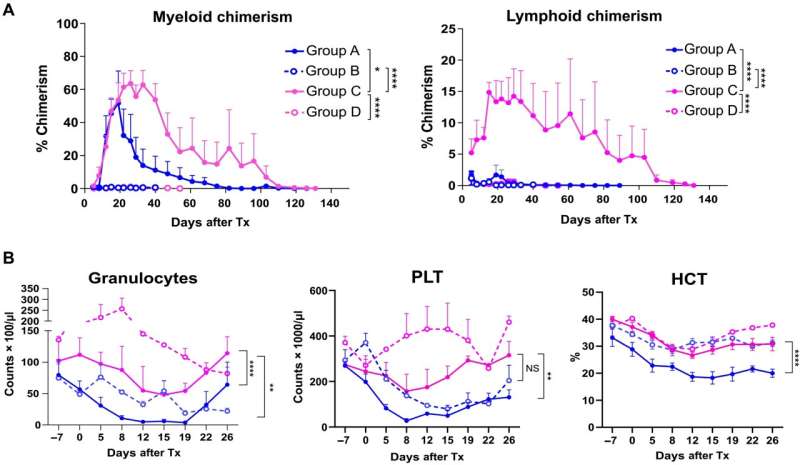April 7, 2023 report
This article has been reviewed according to Science X's editorial process and policies. Editors have highlighted the following attributes while ensuring the content's credibility:
fact-checked
peer-reviewed publication
trusted source
proofread
Less toxic conditioning regimen for bone marrow transplants using an existing drug

A team of researchers led by Tatsuo Kawai of Massachusetts General Hospital, Department of Surgery, Harvard Medical School, Boston, has found a less-intensive way to promote bone marrow transfusion success. In their paper, "Selective Bcl-2 inhibition promotes hematopoietic chimerism and allograft tolerance without myelosuppression in nonhuman primates," published in Science Translational Medicine, the researchers detail how a currently FDA-approved drug for the treatment of chronic lymphocyte leukemia (CLL) can be used to make hematopoietic stem cell transplantation conditioning regimens less toxic.
Hematopoietic stem cells can turn into any kind of blood cell. Hematopoietic stem cell transplantation is the introduction of these cells to the bone marrow (where blood is produced) of patients who have blood manufacturing pathologies such as leukemias, lymphomas and immune deficiency disorders.
In a typical lead-up to a bone marrow transplant, the body undergoes a conditioning regimen. This is a full-body, high-dose chemotherapy exposure that kills the malignant cells in the bone marrow. It also intentionally causes immunosuppression to prevent transplant rejection and provide niches for the new stem cells to take over. This is a multiday process during which the patient can experience severe fatigue, weakness, dizziness, trouble breathing, fast heartbeat, fever, easy bruising, abnormal bleeding, difficulty talking, eating, and sleeping, nausea, vomiting, diarrhea, fever, susceptibility to infection, pain and even death.
While there are plenty of enjoyable behaviors that people willingly indulge in with a potential side effect risk of death, full-body irradiation is not typically one of them. However, when the alternative is continuing to have cancer, there can be little other choice.
Unfortunately, some people do make other choices, fearing the cure to be worse than the disease. They might then seek alternatives and find themselves binging on germanium-infused grape seed extract and subjecting themselves to medieval quackery. An entire industry of grift is built around people's fear of intensive cancer treatments.
Steve Jobs, the founder of Apple, famously put off an urgently needed cancer treatment for nearly a year, opting instead for acupuncture, juice therapy and spiritual rejuvenation therapy. He might be alive today had he not been so afraid of the cure, as would tens of thousands of men who have died of prostate cancer because they were intimidated by much less invasive colonoscopy screenings. Fear of treatment is a significant barrier to choosing to receive treatment, so less frightening conditioning treatments could save lives by lowering the potentially toxic side effects.
The researchers note that previous research suggested that suppressing the protein Bcl2 was associated with the acceptance of infused hematopoietic stem cells in mice while avoiding conventional myelosuppressive conditioning. In the previous study, Bcl-2 was inhibited along with another protein, so its role could not be determined as causative but correlative. The researchers decided to isolate the role of Bcl-2 to determine its role more precisely.
With potential future clinical applications in mind, the researchers chose venetoclax, an already FDA-approved and highly selective Bcl-2 inhibitor with demonstrated safety and efficacy in clinical trials for chronic lymphocytic leukemia (CLL).
The study found that while Bcl-2 inhibition alone was not enough to induce donor stem cell acceptance in a primate model, the addition of venetoclax to a conditioning regimen resulted in stem cell integration with only half the previously administered irradiation dose. It also promoted long-term immunosuppression-free survival of the major histocompatibility complex.
Reducing total body irradiation by half would significantly advance cancer treatments and potentially reduce the risk of toxic side effects—including death. While this proof-of-concept study shows effectiveness in monkeys, it does so with little previous experimentation. The authors suggest that better results are possible in the future as drug dosage and timing are made more efficient.
As positive as this outcome was, the research team plans to follow up with additional targeted protein inhibition studies with the goal of eliminating the need for total body irradiation completely.
More information: Hajime Sasaki et al, Selective Bcl-2 inhibition promotes hematopoietic chimerism and allograft tolerance without myelosuppression in nonhuman primates, Science Translational Medicine (2023). DOI: 10.1126/scitranslmed.add5318
© 2023 Science X Network




















